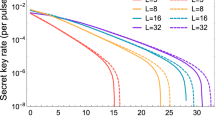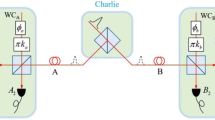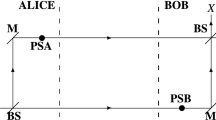Abstract
In existing quantum key distribution protocols, two legitimate peers, Alice and Bob, must monitor the signal disturbance to place a bound on the potential information leakage. However, in the round-robin differential phase shift (RRDPS) protocol, monitoring of the signal disturbance is unnecessary. Here, we present the first active implementation of the RRDPS protocol. In our experiment, Alice prepares packets of pulses, where each packet is a train with 65 pulses and the global phase of each packet is randomized. Bob uses a novel actively controlled variable-delay interferometer to realize the random switching of different delays. Benefiting from the large pulse number of each packet, and the high stability and low insertion loss of the interferometer, the system can distribute a secret key over a distance of 90 km. Our experimental demonstration and results confirm the feasibility of the RRDPS protocol, particularly in high-error situations.
This is a preview of subscription content, access via your institution
Access options
Subscribe to this journal
Receive 12 print issues and online access
$209.00 per year
only $17.42 per issue
Buy this article
- Purchase on Springer Link
- Instant access to full article PDF
Prices may be subject to local taxes which are calculated during checkout




Similar content being viewed by others
References
Bennett, C. H. & Brassard, G. in Proceedings of the IEEE International Conference on Computers, Systems and Signal Processing 175–179 (IEEE, 1984).
Stucki, D., Gisin, N., Guinnard, O., Ribordy, G. & Zbinden, H. Quantum key distribution over 67 km with a plug&play system. New J. Phys. 4, 41 (2002).
Takesue, H. et al. Quantum key distribution over a 40-dB channel loss using superconducting single-photon detectors. Nature Photon. 1, 343–348 (2007).
Wang, S. et al. 2 GHz clock quantum key distribution over 260 km of standard telecom fiber. Opt. Lett. 37, 1008–1010 (2012).
Korzh, B. et al. Provably secure and practical quantum key distribution over 307 km of optical fibre. Nature Photon. 9, 163–168 (2015).
Dixon, A., Yuan, Z., Dynes, J., Sharpe, A. & Shields, A. Gigahertz decoy quantum key distribution with 1 Mbit/s secure key rate. Opt. Express 16, 18790–18797 (2008).
Dixon, A. et al. High speed prototype quantum key distribution system and long term field trial. Opt. Express 23, 7583–7592 (2015).
Jouguet, P., Kunz-Jacques, S., Leverrier, A., Grangier, P. & Diamanti, E. Experimental demonstration of long-distance continuous-variable quantum key distribution. Nature Photon. 7, 378–381 (2013).
Rubenok, A., Slater, J. A., Chan, P., Lucio-Martinez, I. & Tittel, W. Real-world two-photon interference and proof-of-principle quantum key distribution immune to detector attacks. Phys. Rev. Lett. 111, 130501 (2013).
Tang, Z. et al. Experimental demonstration of polarization encoding measurement-device-independent quantum key distribution. Phys. Rev. Lett. 112, 190503 (2014).
Peev, M. et al. The SECOQC quantum key distribution network in Vienna. New J. Phys. 11, 075001 (2009).
Sasaki, M. et al. Field test of quantum key distribution in the Tokyo QKD network. Opt. Express 19, 10387–10409 (2011).
Wang, S. et al. Field and long-term demonstration of a wide area quantum key distribution network. Opt. Express 22, 21739–21756 (2014).
Frolich, B. et al. A quantum access network. Nature 501, 69–72 (2013).
Lo, H.-K., Curty, M. & Tamaki, K. Secure quantum key distribution. Nature Photon. 8, 595–604 (2014).
Gisin, N., Ribordy, G., Tittel, W. & Zbinden, H. Quantum cryptography. Rev. Mod. Phys. 74, 145–195 (2002).
Scarani, V. et al. The security of practical quantum key distribution. Rev. Mod. Phys. 81, 1301–1350 (2009).
Sasaki, T., Yamamoto, Y. & Koashi, M. Practical quantum key distribution protocol without monitoring signal disturbance. Nature 509, 475–478 (2014).
Deutsch, D. et al. Quantum privacy amplification and the security of quantum cryptography over noisy channels. Phys. Rev. Lett. 77, 2818 (1996).
Zhang, C. M. et al. Delayed error verification in quantum key distribution. Chin. Sci. Bull. 59, 2825–2828 (2014).
Pawlowski, M. et al. Information causality as a physical principle. Nature 461, 1101–1104 (2009).
Zhao, Y., Qi, B. & Lo, H.-K. Experimental quantum key distribution with active phase randomization. Appl. Phys. Lett. 90, 044106 (2007).
Mo, X.-F., Zhu, B., Han, Z.-F., Gui, Y.-Z. & Guo, G.-C. Faraday–Michelson system for quantum cryptography. Opt. Lett. 30, 2632–2634 (2005).
Ma, L. et al. 1310 nm differential-phase-shift QKD system using superconducting single-photon detectors. New J. Phys. 11, 045020 (2009).
Walenta, N. et al. Sine gating detector with simple filtering for low-noise infra-red single photon detection at room temperature. J. Appl. Phys. 112, 063106 (2012).
Yuan, Z., Dixon, A., Dynes, J., Sharpe, A. & Shields, A. Gigahertz quantum key distribution with InGaAs avalanche photodiodes. Appl. Phys. Lett. 92, 201104 (2008).
Hwang, W.-Y. Quantum key distribution with high loss: toward global secure communication. Phys. Rev. Lett. 91, 057901 (2003).
Wang, X.-B. Beating the photon-number-splitting attack in practical quantum cryptography. Phys. Rev. Lett. 94, 230503 (2005).
Lo, H.-K., Ma, X. & Chen, K. Decoy state quantum key distribution. Phys. Rev. Lett. 94, 230504 (2005).
Zhang, C. M. et al. Decoy-state measurement-device-independent quantum key distribution with mismatched-basis statistics. Sci. China Phys. Mech. Astron. 58, 590301 (2015).
Acknowledgements
The authors thank J.-D. Wang and J.-Z. Huang for scientific discussions. This work was supported by the National Natural Science Foundation of China (grant nos. 61475148, 61201239, 61205118 and 11304397), the National Basic Research Program of China (grant nos. 2011CBA00200 and 2011CB921200) and the Strategic Priority Research Program (B) of the Chinese Academy of Sciences (grant nos. XDB01030100 and XDB01030300).
Author information
Authors and Affiliations
Contributions
S.W. and Z.-Q.Y. contributed equally to this work. S.W., Z.-Q.Y., W.C., G.-C.G. and Z.-F.H. conceived and designed the experiments. S.W., W.C. and X.-T.S. designed the variable-delay interferometer. S.W., D.-Y.H. and Z.Z. designed the control and detection parts of the system. Z.-Q.Y., W.C. and L.-J.Z. designed the software. All authors performed the experiments. Z.-Q.Y. and H.-W.L. performed the simulation and analysed the data. S.W., Z.-Q.Y., W.C. and Z.-F.H. wrote the paper.
Corresponding authors
Ethics declarations
Competing interests
The authors declare no competing financial interests.
Supplementary information
Supplementary information
Supplementary information (PDF 2211 kb)
Rights and permissions
About this article
Cite this article
Wang, S., Yin, ZQ., Chen, W. et al. Experimental demonstration of a quantum key distribution without signal disturbance monitoring. Nature Photon 9, 832–836 (2015). https://doi.org/10.1038/nphoton.2015.209
Received:
Accepted:
Published:
Issue Date:
DOI: https://doi.org/10.1038/nphoton.2015.209
This article is cited by
-
Measurement-device-independent three-party quantum secure direct communication
Quantum Information Processing (2023)
-
Performance influence on reference-frame-independent quantum key distributions with detection imperfections
Quantum Information Processing (2022)
-
Performance analysis of inter-satellite round-robin differential-phase-shift quantum key distribution
Quantum Information Processing (2022)
-
One-step device-independent quantum secure direct communication
Science China Physics, Mechanics & Astronomy (2022)
-
Tight finite-key analysis for quantum key distribution without monitoring signal disturbance
npj Quantum Information (2021)



